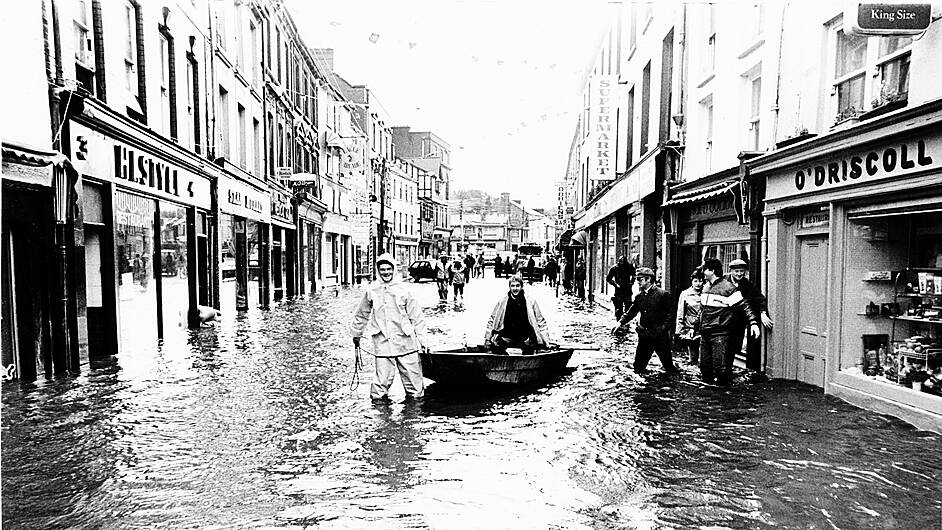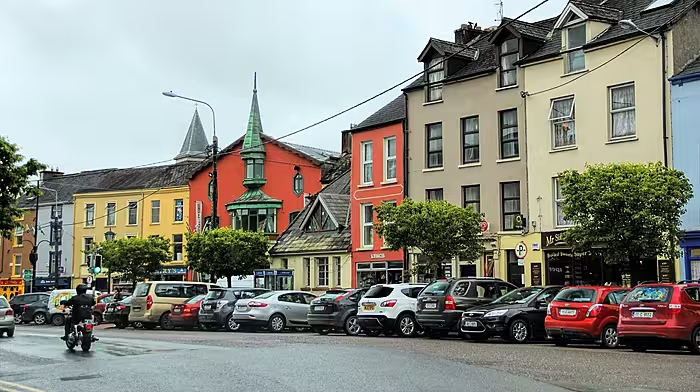The Bath Chronicle of 31 August 1769 reported that: ‘We hear from the Barony of Carbery, in Ireland, that many bridges have been carried away, roads broke up, many ditches thrown down, the towns of Bridgetown and Skibbereen laid under water, and his Majesty’s stores and collector’s apartments very much damaged, by the heavy rain that fell on the 11t instant’.
Flooding has been a perennial problem in Skibbereen for centuries, most likely from the time a settlement grew up on the banks of the Ilen River in the 1600s.
In the mid-19th century, the Board of Guardians in Skibbereen proposed the widening and deepening of the riverbed to ‘save the town from the floods and inundations to which it is every year subject’. But while the problem of flooding persisted and got progressively worse, the talking continued, and little was done to ease the situation.
The issue of solving the flooding problem in Skibbereen seemed to have been consigned to the hallowed hall of Irish aspirations, much like the draining of the Shannon and other projects. That was until a new committee was formed in Skibbereen in February 1982. Skibbereen Flood Committee members quickly realised that for any significant flood relief scheme they were talking about a thirty-to-forty-year timescale, and they were in this for the long haul.
It was also evident from preliminary studies that any satisfactory solution would have to comprise three critical infrastructural developments – a sewage system, relief road and a flood relief scheme. This would be a massive task!
At the inaugural meeting of Skibbereen Floods Committee on February 25th 1982, Cathal O’Donovan was elected secretary. Cathal has been intimately involved with every aspect of the work of the committee for the past forty years. Nobody knows more about how the enormous three-stranded infrastructural developments were brought to completion in 2020.
Cathal is uniquely qualified to tell the story of the Skibbereen Floods Committee and in the Skibbereen Historical Journal 2021, he has written a comprehensive account of the work carried out over the past forty years which has culminated with the centuries old flooding problem in Skibbereen finally being solved!
‘Skibbereen Flooding: a record in time’ is one of fourteen articles covering a diverse range of topics of local and national interest in Skibbereen Historical Journal, Volume 17, 2021.
The journal includes two very timely articles, the centenary of which occur this year. ‘Raid on the Fastnet Lighthouse’, by Eugene Daly, is an account of the daring and very dangerous raid on the Fastnet Lighthouse by members of the Schull Battalion of the IRA in June 1921. William Casey writes of the burials of three neighbours which took place in Aughadown Graveyard in February 1921, three victims of the War of Independence, but from very different backgrounds.
Jerome Geaney’s story of ‘The Creameries of West Cork: A look back over a century’, is a great work of local history that chronicles the beginning and evolution of the creameries and co-op movement in this area where agriculture and food production is still our biggest industry.
Eugene McSweeney has written an intriguing story of the Murrahin Amber Necklace. Around 1920 some seventy-one Amber beads were found in a sod of turf by the Sweetnam family in Murrahin North, Kilcoe, near Skibbereen. This was an extraordinary find and the story of how the beads may have come to be in a bog in West Cork is brilliantly recounted by Eugene.
We are all familiar with the terror of a pandemic in 2021, and Brendan Lyons, in a superb study ‘The Robber of Youth’, recalls how the scourge of tuberculosis ravaged society over a century ago.
These are just a sample of the fourteen articles in the journal which maintains the high standard of the previous sixteen issues and is available in book shops in Skibbereen and other outlets in West Cork.







